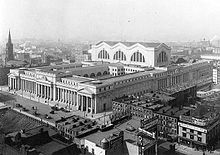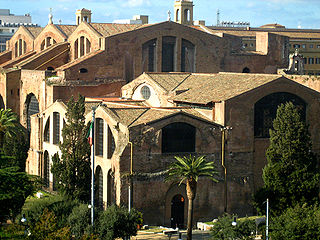- Diocletian window
-
Diocletian windows, also called thermal windows, are large semicircular windows characteristic of the enormous public baths (thermae) of Ancient Rome. They have been revived on a limited basis by some classical revivalist architects in more modern times.
Contents
Description
Diocletian windows are large segmental arched windows (or other openings) which are usually divided into three lights (window compartments) by two vertical mullions. The central compartment is often wider than the two side lights on either side of it.
Names
Diocletian windows are named for the windows found in the Thermae (Baths) of Diocletian (AD 302) in Rome. (The Thermae are now the church of Santa Maria degli Angeli e dei Martiri.) The variant name, thermal window, also comes from their association with the Thermae of Diocletian.
Influence


A five-light variant of the thermal window is seen on the old Penn Station in New York City (circa 1911). This type of window was revived and used in Italy in the 16th century, especially by Andrea Palladio. Palladio and others incorporated an elongated Diocletian window in the form of an arched central light flanked by narrower, square-headed apertures. This combination became known as a Palladian, or Venetian, window.
The Diocletian window was much used in the early 18th century by the English architect Richard Boyle,[1] 3rd Earl of Burlington, one of the originators of the English Palladian style, and by his followers.
Diocletian windows continued to be used occasionally in large public buildings in the various devolutions of neoclassical architecture including the Beaux Arts movement (1880–1920).
References
See also
Categories:- Ancient city of Rome
- Ancient Roman buildings and structures in Rome
- 4th-century architecture
- Late Roman Empire art
- Ancient Roman architecture
- Architectural styles
- British architecture
- Architectural design
- Architectural history
- Windows
Wikimedia Foundation. 2010.

